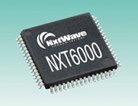NxtWave debuts COFDM decoder

NxtWave Communications (Langhorne, PA) has introduced two new DTV chipsets, including its first for the DVB market.
The new NXT6000 chip for DVB supports the COFDM reception standard and targets the DTV receiver market in Europe and other areas of the world that have adopted the DVB standard. In addition, for the North American market, NxtWave has also introduced the NXT2002, its second generation dual VSB/QAM receiver chip for DTVs, PCs and digital set-top boxes.
NXT6000
 Known for its VSB technology – which the company has claimed improves on the US DTV reception standard – the introduction of the NXT6000 chip represents NxtWave's entry into the European-based DVB market, which uses the COFDM standard. NxtWave has positioned itself in the middle of the current debate over the VSB-COFDM standards and the introduction of its first COFDM chip signals that the company is not putting all its eggs in the VSB basket.
Known for its VSB technology – which the company has claimed improves on the US DTV reception standard – the introduction of the NXT6000 chip represents NxtWave's entry into the European-based DVB market, which uses the COFDM standard. NxtWave has positioned itself in the middle of the current debate over the VSB-COFDM standards and the introduction of its first COFDM chip signals that the company is not putting all its eggs in the VSB basket.
"The NXT6000 marks NxtWave's entry point into the growing DVB-T marketplace," said Matt Miller, president and CEO of NxtWave Communications. "As a global chip company and one that is specifically focused on the DTV market, we offer a great array of superior, cost-effective solutions to OEMs. The NXT6000 COFDM chip is designed to capitalize on the strengths of the DVB-T broadcasting standard and deliver to consumers in DVB markets the benefits of digital high or standard definition video broadcast."
 NXT6000 supports all modes of the DVB-T standard and is designed to meet the mandatory NorDig requirements for digital TV platforms in the Nordic region (Denmark, Finland, Island, Norway and Sweden). The NXT6000's demodulator design can run at substantially less than 800 milliwatts. An on-board controller, along with automatic data acquisition and reacquisition and digital timing recovery features, requires minimal software and reduces costs by eliminating the need for external components.
NXT6000 supports all modes of the DVB-T standard and is designed to meet the mandatory NorDig requirements for digital TV platforms in the Nordic region (Denmark, Finland, Island, Norway and Sweden). The NXT6000's demodulator design can run at substantially less than 800 milliwatts. An on-board controller, along with automatic data acquisition and reacquisition and digital timing recovery features, requires minimal software and reduces costs by eliminating the need for external components.
The chip includes an OFDM demodulator together with Viterbi and Reed Solomon Forward Error Correction (FEC) and an integrated 10-bit Analog to Digital Converter (ADC). The NXT6000 supports both high and low IF tuner architectures using either 36 MHz or 4.57 MHz IF and uses a 2.5 Volt core 0.25-micron process which further reduces the need for external components and enables a high-performance, low power consumption solution.
Available in a compact 64-pin low quad flat pack (LQFP) package, the NXT6000 is priced at $15 in quantities of 10,000. Production quantities are scheduled for Q1 2001.
NXT2002
 The NXT2002, successor to the company's NXT2000 chipset, decodes both VSB signals for digital terrestrial broadcasts as well as 64- or 256- QAM modes for DTV cable connections and DTV interactive reception.
The NXT2002, successor to the company's NXT2000 chipset, decodes both VSB signals for digital terrestrial broadcasts as well as 64- or 256- QAM modes for DTV cable connections and DTV interactive reception.
The NXT2002 is the only VSB/QAM receiver chip to offer the rejection of 0dB echoes. The advanced sparsed equalizer provides better AWGN performance, enhanced multipath tracking and less jitter than conventional equalizers producing a more reliable architecture that enables and maintains signal lock for continuous picture feed. New developments in NXT2002's integrated adaptive control allow for reliable acquisition and reaquisition of DTV signal, resulting in clear high definition reception for consumers, according to NxtWave.
Configurable to operate from a 25 MHz crystal or from an external 25 MHz clock source, the on-chip integration of the direct IF sampling 10-bit ADC, AGC integrator, tuner control, all-digital symbol recovery and the all-digital carrier recovery circuitry further reduces the cost of external components for DTV manufacturers.
Packaged in a 100-pin thin quad flat pack (TQFP), the price of the NXT2002 is $20 each in 10,000 unit quantities. Production quantities are scheduled for Q1 2001.
Source: NxtWave Communications
With contributions from Tom Butts, Managing Editor
